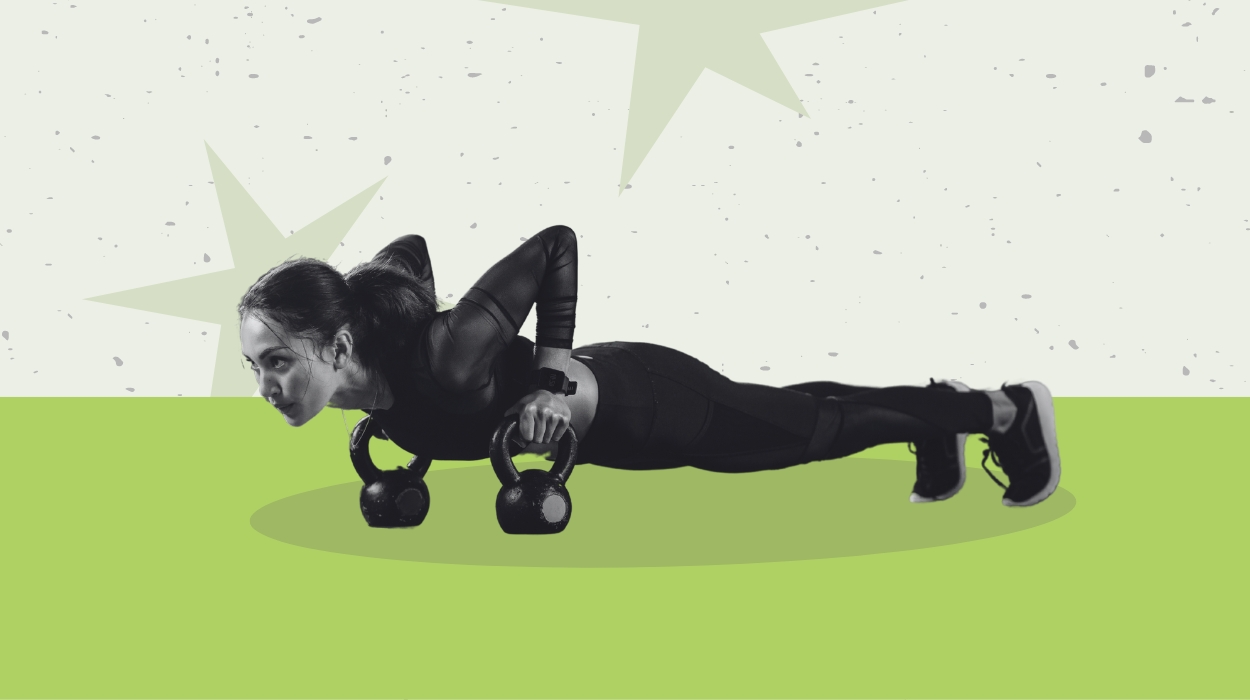
Kettlebell training is a dynamic and effective way to strengthen your core muscles. The combination of weight resistance and functional movements engages your entire body, not just your core. These kettlebell core exercises especially target your abdominal muscles while often engaging supportive muscles for an overall fitness routine.
Kettlebell training can help you burn more calories than other forms of exercise and build muscle and strength. It can also improve your cardiovascular health and reduce your risk for various diseases. This article will explain how to do ten of the best kettlebell exercises and how to mitigate your risk of injury from these and other workouts.
Kettlebell Core Workout: 10 Core Exercises With Kettlebell To Build Functional Strength
These kettlebell exercises will help strengthen and tone your core:
10 Kettlebell Core Exercises To Strengthen Your Core
Kettlebell Russian Twists
This exercise is fantastic for engaging your obliques and improving rotational strength.
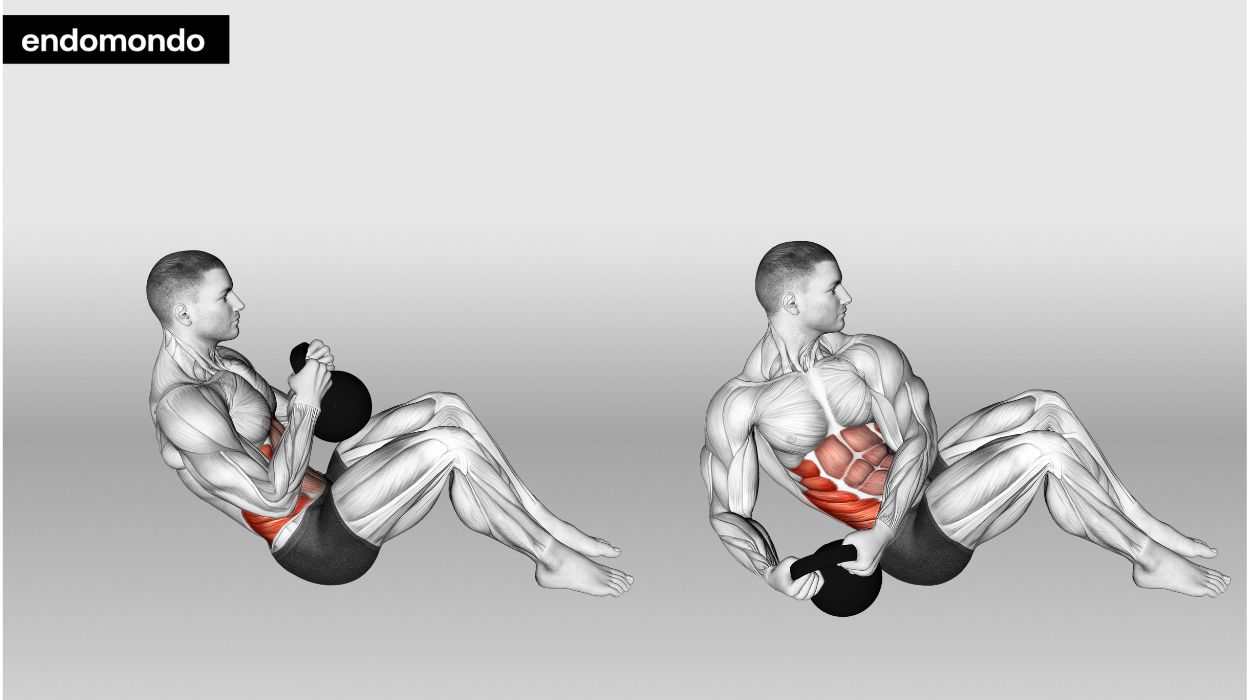
How to do:
- Sit on the floor on a yoga mat with your knees bent and feet flat.
- Hold the kettlebell with both hands close to your chest.
- Lean back slightly at a 45-degree angle, and twist your torso to the left, bringing the kettlebell towards your left hip.
- Alternate sides in a controlled motion, slowly swinging from side to side.
Tips:
- Maintain good posture and engage your core to protect your back during the twist.
- Breathe steadily and focus on controlled movements to maximize effectiveness.
- Avoid hunching or jerky motions; keep the kettlebell close to your body.
Optimal Sets and Reps: 3 sets of 12 to 15 reps on each side.
Kettlebell Windmills
Strengthen your core and improve flexibility with this exercise that targets your obliques and latissimus dorsi muscles.
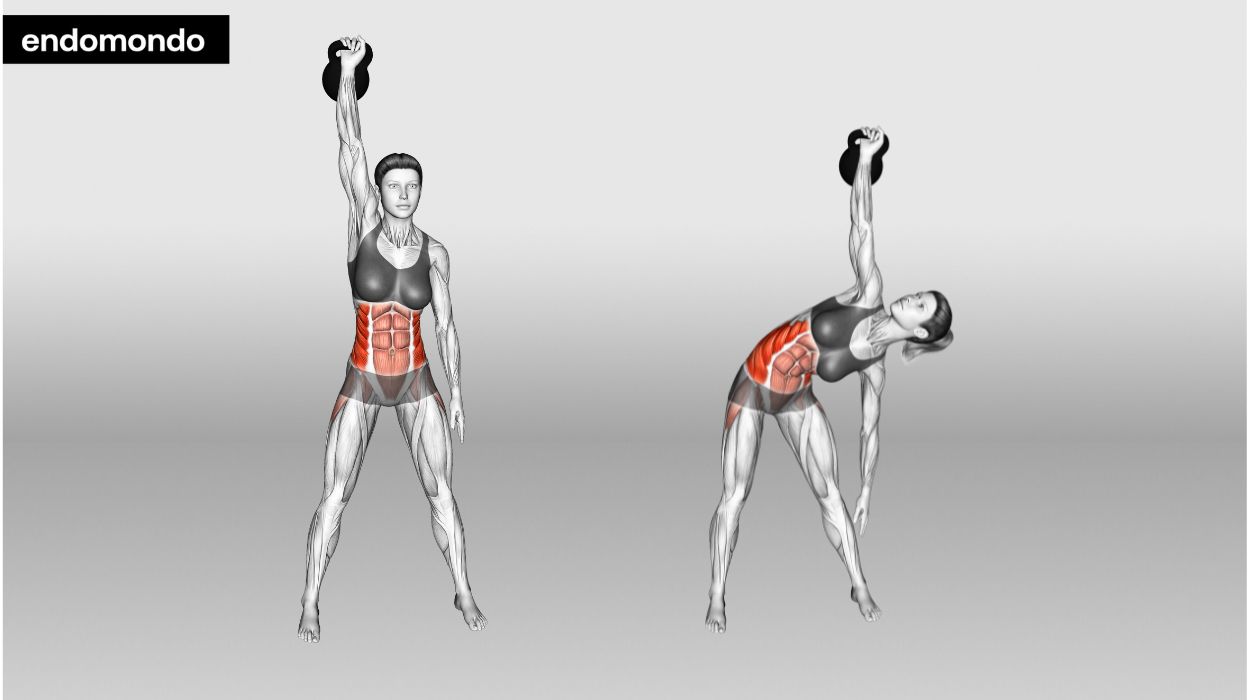
How to do:
- Start with your right foot directly under your hip with your left leg angled out.
- Hold the kettlebell in your right hand, and raise it above your head with your left arm at your side palm up.
- Stand with your feet wider than shoulder-width apart.
- With your left foot outwards, bend to the left, extending your right arm overhead.
- Lower the kettlebell towards the floor while looking up at it.
- Return to the starting position.
- Perform the desired repetitions on this side before flipping to the other side.
Tips:
- Keep your core engaged and maintain a straight arm when reaching down.
- Breathe steadily throughout the movement to support stability and balance.
- Focus on form over weight; start with a manageable kettlebell to avoid strain.
Optimal Sets and Reps: 3 sets of 8 to 10 reps for each side.
Kettlebell Turkish Get-Ups
This full-body exercise is exceptional for core stability and overall strength. If you are new to this exercise, choose a lightweight.
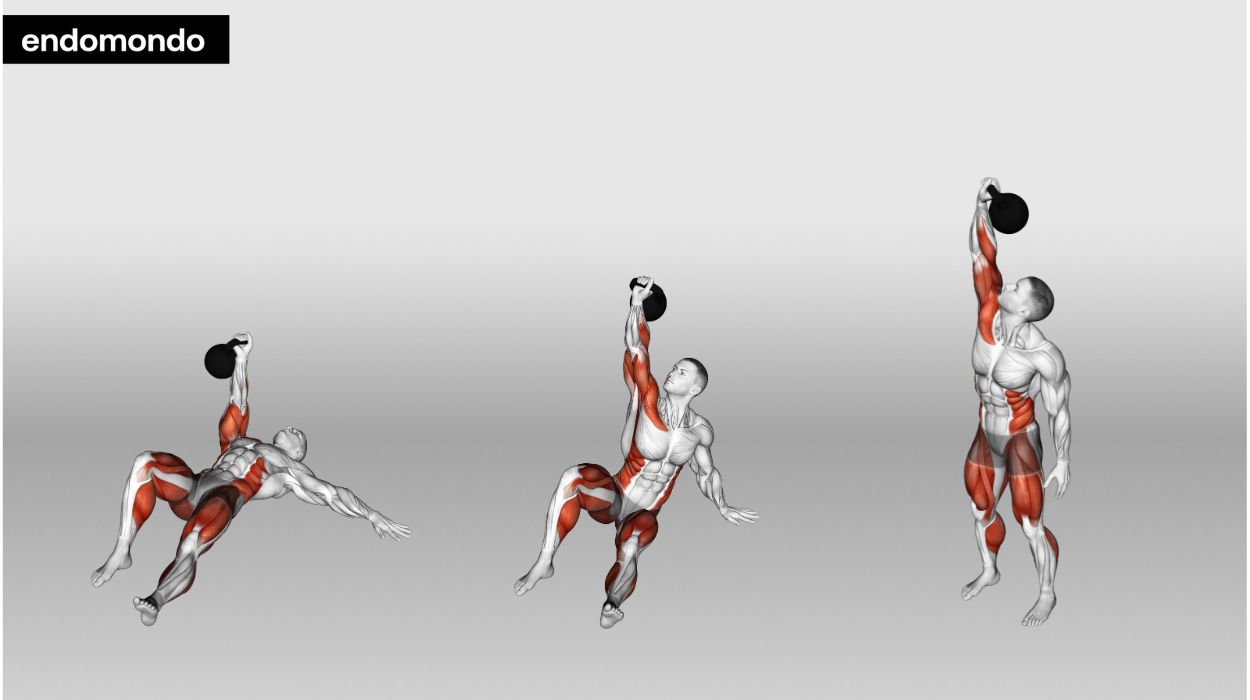
How to do:
- Begin by lying on your back, holding the kettlebell in your right hand.
- Bend your right knee and plant your right foot on the ground, extending your left leg.
- Hold the kettlebell in your right hand, and have that arm extended overhead. Use your left arm to prop yourself up.
- Transition into a standing position, maintaining the kettlebell overhead.
- Reverse the movements to return to the starting position.
Tips:
- Maintain a strong core and steady breathing throughout the entire exercise.
- Ensure your kettlebell hand remains vertical, not tilted, for stability.
- Start with a lighter weight and perfect your form before progressing.
Optimal Sets and Reps: 4 sets of 5 to 6 reps on each side.
Kettlebell Plank Drags
Enhance your core strength and stability with this challenging plank variation.
How to do:
- Start in a high plank position with a kettlebell beside your left hand.
- Reach your right hand across to drag the kettlebell to the right side.
- Alternate sides, focusing on engaging your core and minimizing hip movement.
Tips:
- Maintain a solid plank position with your hips in line with your shoulders.
- Breathe steadily and avoid rounding your back to protect your spine.
- Start with a manageable weight and focus on control to avoid injury.
Optimal Sets and Reps: 10 to 12 drags on each side.
Kettlebell Goblet Squats
Combine leg and upper back strength and core engagement with this powerful squat variation.
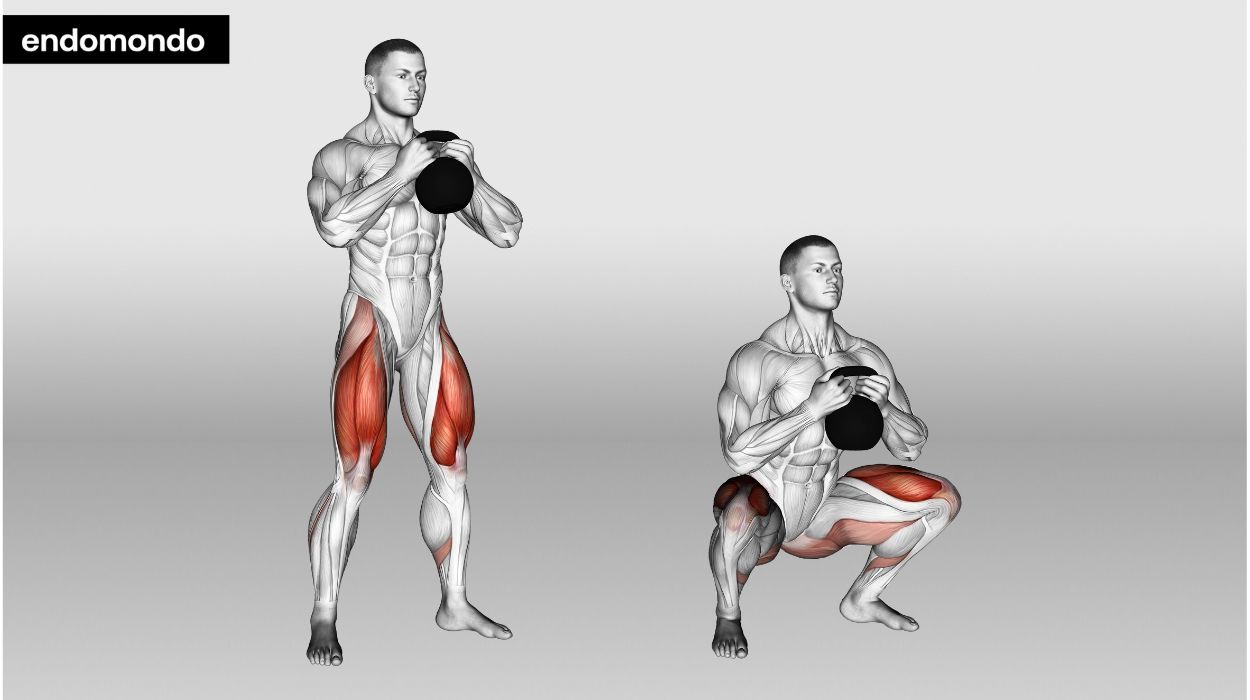
How to do:
- Hold the kettlebell close to your chest with both hands. Tuck your elbows in at the sides.
- Stand with your feet shoulder-width apart.
- Push your glutes back and bend your knees to perform a squat like sitting in a chair, keeping your chest up and spine straight. Do not let your back round.
- Push through your heels to return to the starting position.
Tips:
- Keep your chest up, and core engaged, and maintain an upright posture.
- Breathe deeply throughout the movement to support your stability.
- Ensure your knees track over your toes, preventing them from collapsing inward.
Optimal Sets and Reps: 3 sets of 12 to 15 reps.
Kettlebell Dead Bug
This exercise enhances core stability and coordination.
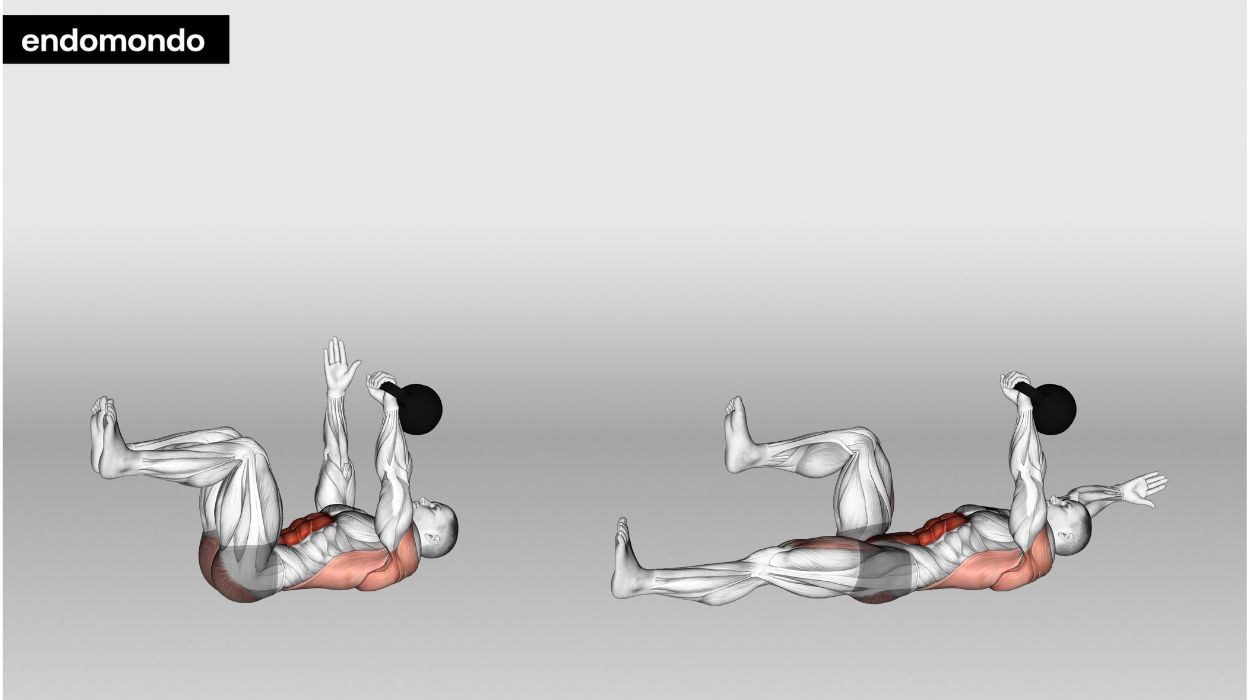
How to do:
- Lie on your back with your feet off the ground and legs at a 90-degree angle. Your arms should be extended above you with a kettlebell in each hand.
- Simultaneously lower your left arm and right leg towards the floor while maintaining core engagement.
- Return to the starting position and alternate sides.
Tips:
- Maintain a neutral spine and engage your core throughout the exercise.
- Exhale as you extend your arm and leg, inhale as you return.
- Focus on controlled movements, avoiding excessive arching or rounding of the back.
Optimal Sets and Reps: 3 sets of 10 to 12 reps on each side.
Kettlebell Halo
Engage your core and shoulders with this dynamic movement.
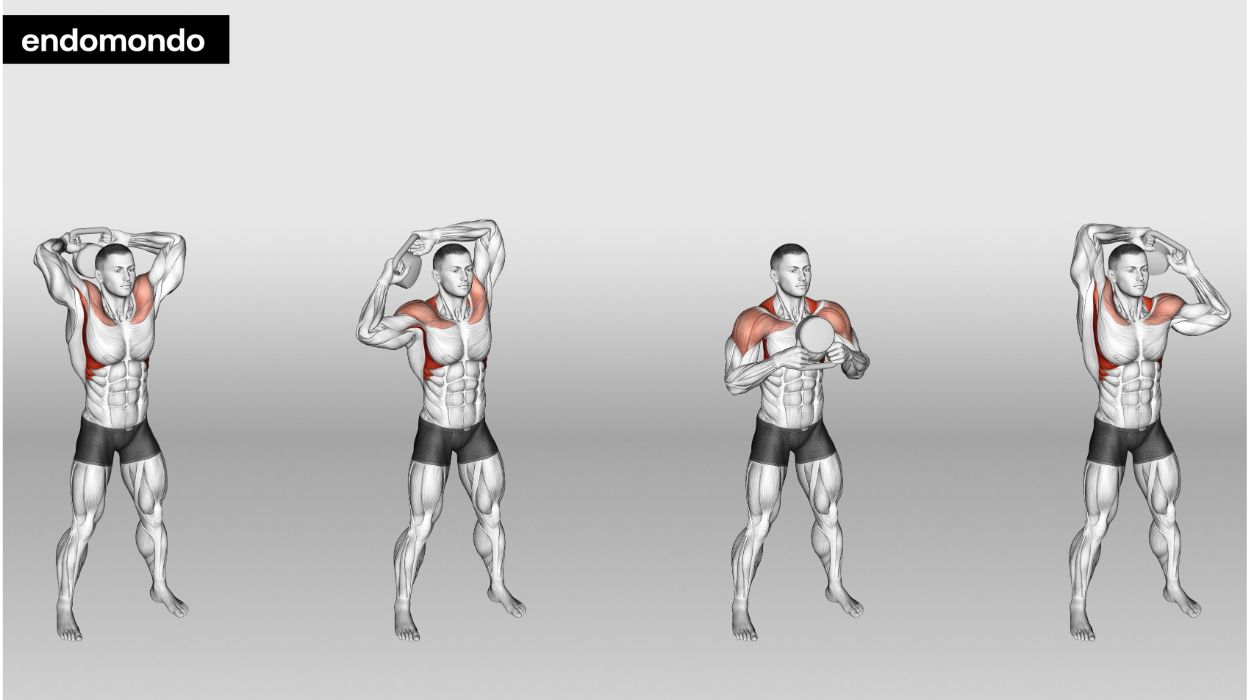
How to do:
- Begin by standing straight with knees straight but not locked.
- Hold the kettlebell by the horns close to your chest.
- Circle the kettlebell to the right around your head in a controlled manner. Let the kettlebell drop slightly behind the neck and finish the circle by bringing it to the left side of your head.
- Change the direction after each circle.
Tips:
- Keep your core engaged and maintain proper posture to protect your spine.
- Breathe steadily and avoid holding your breath during the exercise.
- Start with a lighter kettlebell to ensure control and gradually progress to heavier weights as you become more comfortable with the movement.
Optimal Sets and Reps: 3 sets of 8 to 10 circles in each direction.
Kettlebell Russian Get-Ups
Elevate your core workout with this challenging exercise. It is always best for your joints if you lie on a padded mat like a yoga mat for these exercises.
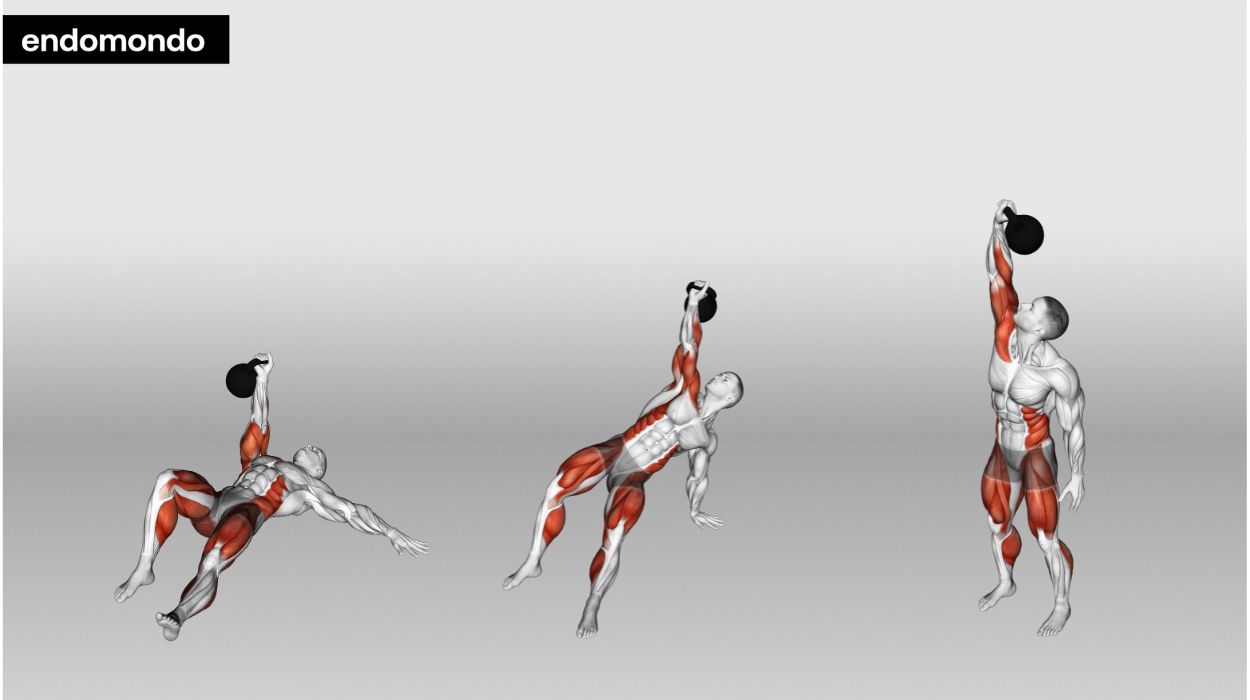
How to do:
- Lie on your back with the kettlebell in your right hand, arm extended.
- Roll onto your left side and push yourself up to a seated position.
- Plant your left hand on the ground and lift your hips into a bridge position.
- Slide your left leg back and kneel on your left knee, still holding the kettlebell.
- Stand up while keeping the kettlebell overhead.
- Reverse the steps to return to the starting position.
Tips:
- Focus on maintaining a strong core and controlled movements throughout the exercise.
- Breathe steadily and avoid holding your breath during each phase.
- Start with a lighter kettlebell to master the technique before increasing weight.
Optimal Sets and Reps: 2 sets of 4 to 5 reps on each side.
Kettlebell Mountain Climbers
Elevate the intensity of your core workout with this dynamic exercise.
How to do:
- Start in a high plank position with your hands on the kettlebell handles, one for each hand.
- Drive your knees towards your chest alternately, engaging your core, extending your arms straight, and holding on to the kettlebells.
- Perform mountain climbers for 30 to 45 seconds.
Tips:
- Keep your hips and core stable while driving your knees toward your chest.
- Maintain a steady breathing pattern to sustain your energy throughout the exercise.
- Avoid rushing the movement; focus on controlled and deliberate motions.
Optimal Sets and Reps: 3 sets of 10-12 reps.
Kettlebell Swings
This classic kettlebell exercise is a powerful way to engage your entire body, especially your core.
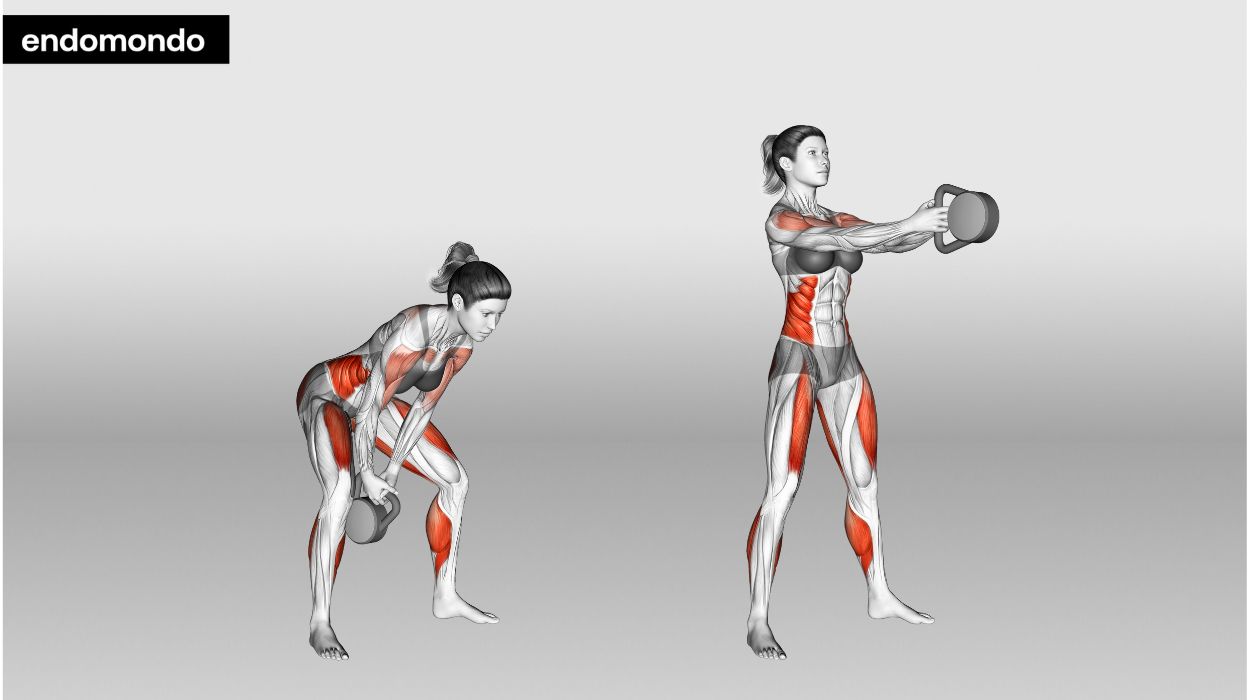
How to do:
- Stand with your feet shoulder-width apart, holding the kettlebell with both hands with arms straight down.
- Hinge at your hips and swing the kettlebell between your legs as you inhale.
- Exhale and explosively thrust your hips forward, propelling the kettlebell to shoulder height.
- Allow the kettlebell to swing back down as you inhale again, and repeat the movement.
Tips:
- Maintain a strong and neutral spine throughout the exercise to protect your back.
- Exhale forcefully as you swing the kettlebell up and inhale during the downward swing.
- Use your hips and glutes to generate the power for the swing, not your arms.
Optimal Sets and Reps: 3 sets of 15 to 20 reps.
Are Kettlebell Workouts Really Good For Core?
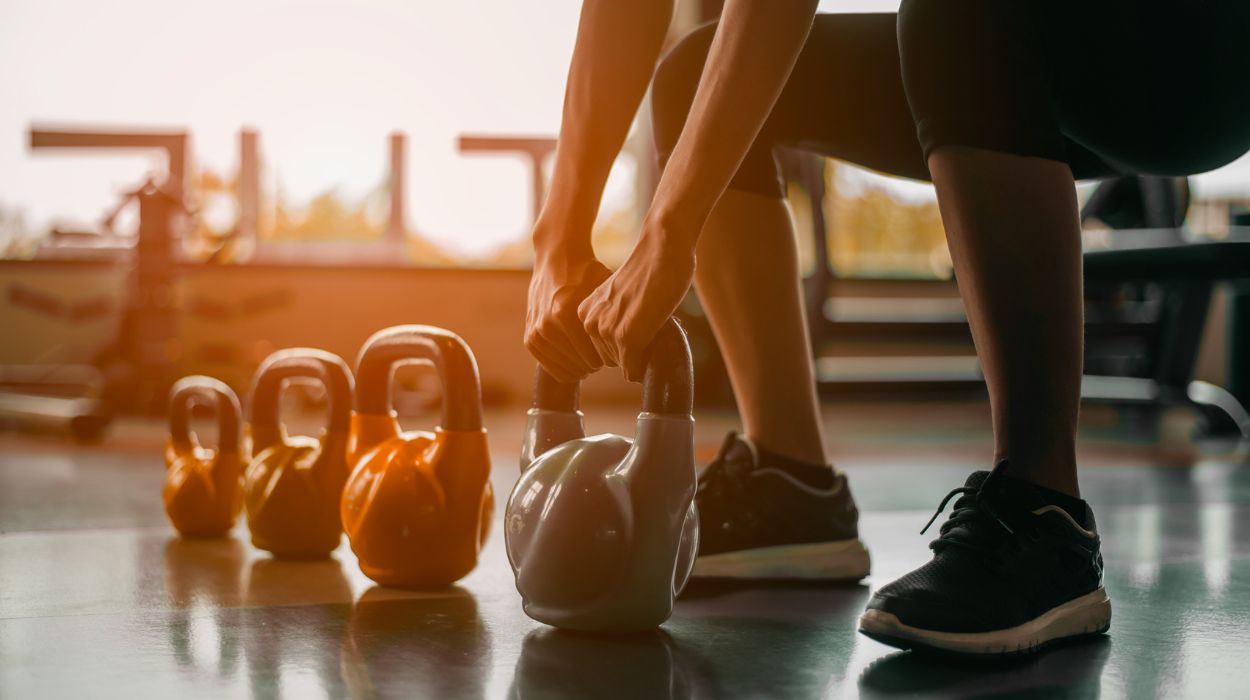
Kettlebell workouts are highly effective for targeting and strengthening your core muscles. The unique design of a kettlebell engages multiple muscle groups, including those in your core, to stabilize your body as you move. This results in improved core strength and enhanced overall functional fitness.
Kettlebell core exercises require your core muscles to work harmoniously with your entire body. The off-center handle of the kettlebell amplifies the challenge as your core muscles engage to stabilize and control the weight during each movement. Kettlebells can allow for more intense workouts[1] than most other alternatives, but they can also be toned down to be more beginner-friendly.
If you incorporate a kettlebell ab workout into your fitness routine, make sure to keep it balanced with other types of workouts, as well as rest and proper nutrition. A balanced lifestyle is best for both weight loss and muscle building.
Things To Consider
- Proper Form and Technique: When performing a kettlebell core exercise, pay attention to your form; bad form is a major source of injuries. Focus on engaging your core muscles, maintaining a neutral spine, and executing each movement with control. You should also make sure to choose the correct kettlebell weight for your body and experience level.
- Breathing Techniques: Proper breathing enhances the effectiveness of these core exercises. Focus on deep inhales and exhales that align with your movements, helping stabilize your core and maintain energy throughout the workout.
- Warm-Up and Cool-Down: Before starting your kettlebell core workout, thoroughly warm up to prepare your muscles and joints for the movements. After the workout, incorporate a cool-down routine to promote flexibility and aid in recovery.
- Have the Right Expectations: If you want to lose weight or build muscle, do not expect rapid progress. The CDC points out that weight loss is more complicated than one kettlebell ab workout; it takes balance and lifestyle change over time.
- Rest and Recovery: Allow your muscles ample time — usually one to two days — to recover between kettlebell training sessions. Overtraining can lead to burnout and an increased risk of injury. Listen to your body and take extra time when you feel you need it.
- Variety and Balance: While kettlebell ab exercises are effective, you should exercise with various movements that target different muscle groups. One meta-analysis[2] found no or weak evidence that kettlebells are better than other kinds of workouts, so keep up the variety.
- Hydration and Nutrition: Stay hydrated before, during, and after your workout. Proper hydration supports your muscles and overall performance. Additionally, fuel your body with a balanced diet rich in nutrients to support muscle-building and recovery.
Conclusion
Kettlebell core exercises provide an effective way to strengthen your core muscles and burn fat. Incorporate these dynamic movements into your routine to enhance your core strength, stability, and overall fitness. Remember to combine your workout with a well-balanced diet, and ample nutrients, and consider using supplements to support your muscle-building goals.
If you follow these steps, you can reap impressive benefits. The British Journal of Sports Medicine found dramatic correlations[3] between weight training and lower risk[4] for various diseases. Kettlebell workouts and other types of strength training, along with a healthy lifestyle, can set you up for success in the gym and life.
Frequently Asked Questions
Yes, kettlebell exercises and other ab workouts can contribute to fat loss, especially when combined with a balanced diet and overall fitness routine. Supplements or a fat burner may also help you lose weight faster.
You could train with kettlebells daily, but allowing your muscles time to recover is important. Aim for a mix of kettlebell and other workouts throughout the week and rest a day or two between workouts, especially similar workouts.
A 20-minute kettlebell workout can be effective if it’s high-intensity and targets various muscle groups. However, individual needs may vary.
For beginners, start with a kettlebell weight that allows you to perform exercises with proper form and complete the recommended reps with moderate effort. Gradually increase weight as you progress.
Resources
- Rodrigo Luiz Vancini, Marília Santos Andrade, Weverton Rufo-Tavares, Zimerer, C., Pantelis Theodoros Nikolaidis and André, C. (2019). Kettlebell Exercise as an Alternative to Improve Aerobic Power and Muscle Strength. Journal of Human Kinetics, [online] 66(1), pp.5–6. doi:https://doi.org/10.2478/hukin-2018-0062.
- Meigh, N.J., Keogh, J.W.L., Schram, B. and Hing, W. (2019). Kettlebell training in clinical practice: a scoping review. BMC Sports Science, Medicine and Rehabilitation, [online] 11(1). doi:https://doi.org/10.1186/s13102-019-0130-z.
- Gorzelitz, J., Trabert, B., Katki, H.A., Moore, S., Watts, E.L. and Matthews, C.E. (2022). Independent and joint associations of weightlifting and aerobic activity with all-cause, cardiovascular disease and cancer mortality in the Prostate, Lung, Colorectal and Ovarian Cancer Screening Trial. British Journal of Sports Medicine, [online] 56(22), pp.1277–1283. doi:https://doi.org/10.1136/bjsports-2021-105315.
- Haruki Momma, Kawakami, R., Honda, T. and Sawada, S.S. (2022). Muscle-strengthening activities are associated with lower risk and mortality in major non-communicable diseases: a systematic review and meta-analysis of cohort studies. British Journal of Sports Medicine, [online] 56(13), pp.755–763. doi:https://doi.org/10.1136/bjsports-2021-105061.




